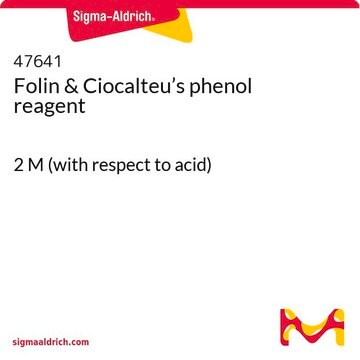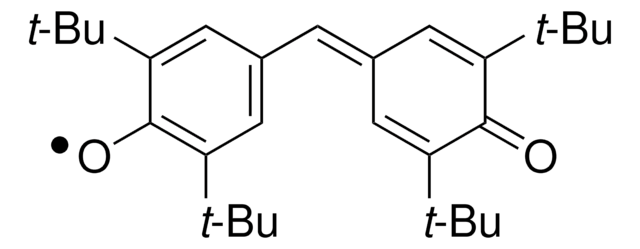300267
DPPH, Free Radical
≥90% (elemental analysis), solid, hydrogen radical scavenger, Calbiochem®
Synonim(y):
DPPH, Free Radical
About This Item
Polecane produkty
product name
DPPH, Free Radical, DPPH, Free Radical, CAS 1898-66-4, is a cell-permeable, stable free radical that acts as a hydrogen radical scavenger.
Poziom jakości
Próba
≥90% (elemental analysis)
Postać
solid
producent / nazwa handlowa
Calbiochem®
warunki przechowywania
OK to freeze
protect from light
kolor
black
rozpuszczalność
DMF: 10 mg/mL
ethanol: 5 mg/mL
Warunki transportu
ambient
temp. przechowywania
−20°C
InChI
1S/C18H13N5O6/c24-21(25)15-11-16(22(26)27)18(17(12-15)23(28)29)19-20(13-7-3-1-4-8-13)14-9-5-2-6-10-14/h1-12,19H
Klucz InChI
WCBPJVKVIMMEQC-UHFFFAOYSA-N
Opis ogólny
Działania biochem./fizjol.
Hydrogen radical scavenger
Ostrzeżenie
Rekonstytucja
Inne uwagi
Karki, S.B., et al. 2000. J. Pharm. Sci.89, 1518.
Ancerewicz, J., et al. 1998. Free Radic. Biol. Med.25, 113.
Dinis, T.C., et al. 1994. Arch. Biochem. Biophys.315, 161.
Informacje prawne
Hasło ostrzegawcze
Danger
Zwroty wskazujące rodzaj zagrożenia
Zwroty wskazujące środki ostrożności
Klasyfikacja zagrożeń
Acute Tox. 4 Dermal - Acute Tox. 4 Inhalation - Acute Tox. 4 Oral - Eye Irrit. 2 - Resp. Sens. 1 - Self-react. C - Skin Irrit. 2 - Skin Sens. 1
Kod klasy składowania
4.1A - Other explosive hazardous materials
Klasa zagrożenia wodnego (WGK)
WGK 1
Temperatura zapłonu (°F)
Not applicable
Temperatura zapłonu (°C)
Not applicable
Certyfikaty analizy (CoA)
Poszukaj Certyfikaty analizy (CoA), wpisując numer partii/serii produktów. Numery serii i partii można znaleźć na etykiecie produktu po słowach „seria” lub „partia”.
Masz już ten produkt?
Dokumenty związane z niedawno zakupionymi produktami zostały zamieszczone w Bibliotece dokumentów.
Klienci oglądali również te produkty
Nasz zespół naukowców ma doświadczenie we wszystkich obszarach badań, w tym w naukach przyrodniczych, materiałoznawstwie, syntezie chemicznej, chromatografii, analityce i wielu innych dziedzinach.
Skontaktuj się z zespołem ds. pomocy technicznej















